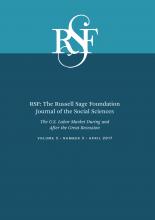Research ArticleI. Longer-Term Impact of the Great Recession on Workers and Firms
Open Access
Weathering the Great Recession: Variation in Employment Responses, by Establishments and Countries
Erling Barth, James Davis, Richard Freeman, Sari Pekkala Kerr
RSF: The Russell Sage Foundation Journal of the Social Sciences April 2017, 3 (3) 50-69; DOI: https://doi.org/10.7758/RSF.2017.3.3.03
Erling Barth
aResearch professor at the Institute for Social Research, Oslo; professor II at the Center for the Study of Equality and Social Organization at the Department of Economics, University of Oslo; and research economist at the National Bureau of Economic Research
James Davis
bEconomist and RDC administrator and team lead at the U.S. Census Bureau
Richard Freeman
cAscherman Professor of Economics at Harvard University and director of the Sloan Science Engineering Workforce Project at the National Bureau of Economic Research
Sari Pekkala Kerr
dSenior research scientist at Wellesley College

REFERENCES
- ↵Abraham, Katherine, John C. Haltiwanger, Kristin Sandusky, and James R. Spletzer. 2016. “Measuring the Gig Economy.” Available at: www.sole-jole.org/16375.pdf; accessed August 4, 2016.
- ↵Acemoglu, Daron, David Autor, David Dorn, Gordon H. Hanson, and Brendan Price. 2014. “Return of the Solow Paradox? IT, Productivity, and Employment in U.S. Manufacturing,” IZA Discussion Paper No. 7906. January 2014. Available at: http://hdl.handle.net/1721.1/95917; accessed October 20, 2016.
- ↵Assous, Michaël. 2013. “Struggle with Medium-Run Macroeconomics: 1956–1995.” CHOPE Working Paper No. 2013-17. Available at: https://hope.econ.duke.edu/sites/hope.econ.duke.edu/files/Assous%20Sept%2013%202013-2.pdf; accessed August 4, 2016.
- ↵
- ↵Basu, Susanto, and John Fernald. 2001. “Why Is Productivity Procyclical? Why Do We Care?” In New Developments in Productivity Analysis, edited by Charles R. Hultin, Edwin R. Dean, and Michael J. Harper. Cambridge, Mass.: National Bureau of Economic Research.
- ↵
- ↵Cazes, Sandrine, Sameer Khatiwada, and Miguel Malo. 2012. “Employment Protection and Collective Bargaining: Beyond the Deregulation Agenda.” ILO Employment Working Paper No. 133. Geneva: International Labour Office.
- ↵Davis, Steve, John Haltiwanger, Scott Schuh. 1996. Job Creation and Destruction. Cambridge, Mass.: MIT Press, 1996.
- Foster, Lucia,
- Cheryl Grim, , and
- John Haltiwanger
- ↵
- Freeman, Richard B
- ↵Haltiwanger, John. 2012. “Job Creation and Firm Dynamics in the United States.” In Innovation Policy and the Economy, vol. 12, edited by Josh Lerner and Scott Stern. Chicago: University of Chicago Press.
- ↵Holt, Charles C., Franco Modigliani, John F. Muth, and Herbert A. Simon. 1960. Planning Production, Inventories, and Work Force. Englewood Cliffs, N.J.: Prentice-Hall.
- ↵
- Houseman, Susan,
- Christopher Kurz, ,
- Paul Lengermann, , and
- Benjamin Mandel
- ↵Jarmin, Ron S., and Javier Miranda. 2002. “The Longitudinal Business Database.” CES Working Paper 02–17. Washington: Census Bureau, Center for Economic Studies.
- ↵Katz, Larry, and Alan Kreuger. 2016. “The Rise and Nature of Alternative Work Arrangements in the United States, 1995–2015.” Cambridge, Mass.: Harvard University and National Bureau for Economic Research, March. Available at: http://scholar.harvard.edu/files/lkatz/files/katz_krueger_cws_v3.pdf; accessed August 4, 2016.
- ↵Okun, Arthur. 1970. The Political Economy of Prosperity. New York: Norton.
- Pugsley, Benjamin, and Ayşegül Şahin. 2014. “Grown-Up Business Cycles.” Federal Reserve Bank of New York Staff Report No. 707. New York: Federal Reserve Bank of New York, December. Available at: www.newyorkfed.org/medialibrary/media/research/staff_reports/sr707.pdf; accessed August 4, 2016.
- ↵Solow, Robert R. 1964. “Draft of Presidential Address on the Short Run Relation of Employment and Output.” Robert Solow papers, Box 70, Folder 1964, David M. Rubenstein Rare Book & Manuscript Library, Duke University, Durham, N.C.
- ↵Weil, David. 2014. The Fissured Workplace. Cambridge, Mass.: Harvard University Press.
In this issue
Weathering the Great Recession: Variation in Employment Responses, by Establishments and Countries
Erling Barth, James Davis, Richard Freeman, Sari Pekkala Kerr
RSF: The Russell Sage Foundation Journal of the Social Sciences Apr 2017, 3 (3) 50-69; DOI: 10.7758/RSF.2017.3.3.03
Jump to section
Related Articles
- No related articles found.
Cited By...
- No citing articles found.





